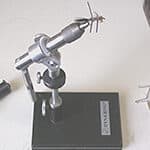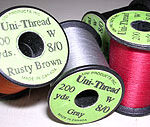The best fly-tying tips I have learned over the years.
Pedestal vs. C-clamp Fly Tying Vise
I prefer a pedestal vise to the c-clamp models, especially when on the road. Too many cheap motels don’t have a good place to clamp your tying vise.
While there are tyers on a higher plane, who can tie flies by holding the hook in their hands, for most of us it is a critical tool. The primary job of the vise, which amazingly, some vises fail to accomplish, is to hold the hook firmly in place without movement of any kind. The hook should bend before it is allowed to shift in the vise.
My current vise is a Dyna King Squire, a very well-machined vise. Previously I have also used a Regal and liked it very much. The Regal is especially suited to production fly tying.
Read Good Fly Tying Books
Purchase one or more fly pattern reference books with recipes. The following are some good ones. There are many more:
The Book Of Fly Patterns by Eric Leiser
Flies For Trout by Dick Stewart & Farrow Allen
Fly Patterns Of Yellowstone by Craig Mathews & John Juracek
Fly Patterns Of Umpqua Feather Merchants by Randall Kaufmann

Purchase how-to books with photos and step-by-step tying instructions.
Some personal favorites:
The Fly Tyers Nymph Manual by Randall Kaufmann
Tying Dry Flies, Revised Edition by Randall Kaufmann
Tying Flies With Jack Dennis And Friends by Jack Dennis, edited by Joe Burke
Production Fly Tying: A Collection of Ideas, Notions, Tips & Variations on the Techniques of Fly Tying by A.K. Best, John Gierach. This is a great book for learning fly tying techniques.
Learn to Tie From the Pros
There is no substitute for hands-on instruction. If you can swing it, take a fly-tying class in your area. They’re usually offered in the winter.
Attend the ever-growing number of fly-tying expositions popping up across the country. The scope and variety of ideas you’ll be exposed to under one roof is well worth the effort.
Use the Lightest Thread You Can Get Away With
8/0 Uni-Thread is very strong and easy to use. It has replaced the 6/0 (and even 3/0) thread on flies I tie.
By using the lightest thread you can, you actually increase the durability of the flies you tie. Lighter threads not only reduce bulk, but allows for more turns of thread to be applied without adding undue weight which is, of course, of paramount importance on dry flies.
Regardless of the type of fly, you are tying, adding more thread wraps will increase the fly’s durability.
Reverse Engineer Flies You Want to Learn to Tie
If you can’t figure out how to tie a particular fly, reverse engineer it. Unwind the thread starting at the head and pay close attention to its construction. Lots of great fly tyers learned their trade this way.
